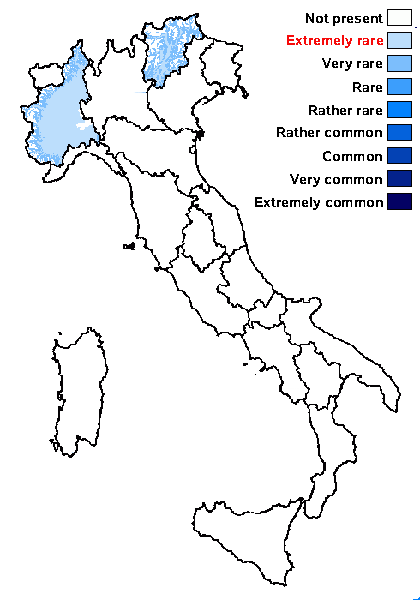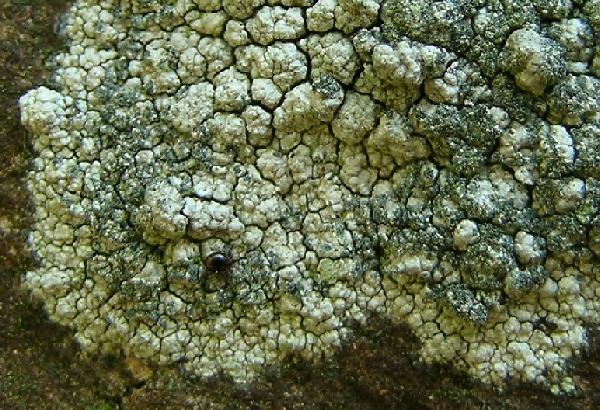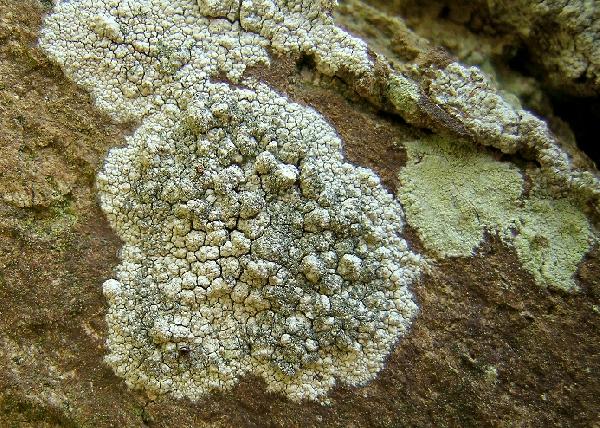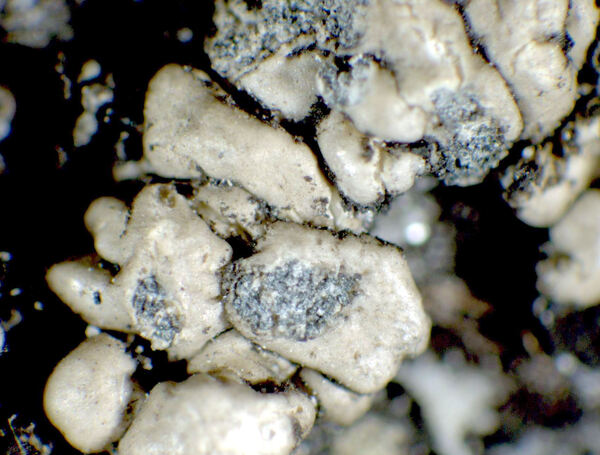Lecanora pannonica Szatala
Ann. Hist. Nat. Mus. Nat. Hung., ser. nov. 5: 135, 1954.
Synonyms:
Distribution: N - TAA (Brodo & al. 1994), Piem (Gheza & Nascimbene 2024).
Description: Thallus crustose, episubstratic, bullate-areolate or of dispersed, wart-like, ecorticate areoles, yellowish grey to yellowish white, slightly shiny, without a clear prothallus, the areoles usually strongly convex, 0.7-1.5 mm wide, sorediate. Soralia greenish or greyish black to dark blue-green, discrete, round and laminal to elongate and marginal, level with thallus or slightly excavate, 0.5-1.5 mm wide; soredia granular, 35-50 µm. Apothecia rare, lecanorine, sessile to slightly constricted at base, 0.8-1.5 mm across, with a dark greyish brown, epruinose disc and a prominent, more or less flexuose thalline margin sometimes blackening on inner rim. Thalline exciple corticate, the cortex (20-)37-35(-40) µm thick, containing large, irregular crystals visible under polarized light; proper exciple thin, colourless, without crystals; epithecium yellowish brown, K+ olivaceous green, with crystals dissolving in K; hymenium colourless, 45-55 µm high; paraphyses slightly branched in upper parts, not capitate; hypothecium colourless. Asci 8-spored, clavate, very thin-walled, with a K/I+ blue, tall tholus penetrated by a faintly amyloid apical cushion, the wall K/I-, surrounded by a blue outer layer, Lecanora-type. Ascospores 1-celled, hyaline, broadly ellipsoid to ellipsoid, 9-15 x (5-)6-7.5 µm. Photobiont chlorococcoid. Spot tests: cortex and medulla K+ yellow, C-, KC-, P- or P+ faintly yellow, UV-; soralia K+ pale yellow (K+ green, N+ red under the microscope). Chemistry: atranorin (major), chloratranorin (minor), roccellic acid and gangaleoidin (traces), and sometimes unidentified fatty acids. Note: on hard siliceous rocks, also on man-made substrata in the Alps, especially on vertical faces; very much overlooked, or confused with other species.
Growth form: Crustose
Substrata: rocks
Photobiont: green algae other than Trentepohlia
Reproductive strategy: mainly asexual, by soredia, or soredia-like structures (e.g. blastidia)
Species of metal-rich rocks
Commonnes-rarity: (info)
Alpine belt: absent
Subalpine belt: very rare
Oromediterranean belt: absent
Montane belt: very rare
Submediterranean belt: extremely rare
Padanian area: absent
Humid submediterranean belt: absent
Humid mediterranean belt: absent
Dry mediterranean belt: absent

Predictive model

Ulrich Kirschbaum CC BY-SA 4.0 - Source: https://www.thm.de/lse/ulrich-kirschbaum/flechtenbilder
Central Europe; Germany: Hesse. (150 m above sea level). (Coll/ident: Eichler/Cezanne).

Ulrich Kirschbaum CC BY-SA 4.0 - Source: https://www.thm.de/lse/ulrich-kirschbaum/flechtenbilder
Central Europe; Germany: Hesse. (150 m above sea level). (Coll/ident: Eichler/Cezanne).
Growth form: Crustose
Substrata: rocks
Photobiont: green algae other than Trentepohlia
Reproductive strategy: mainly asexual, by soredia, or soredia-like structures (e.g. blastidia)
Species of metal-rich rocks
Commonnes-rarity: (info)
Alpine belt: absent
Subalpine belt: very rare
Oromediterranean belt: absent
Montane belt: very rare
Submediterranean belt: extremely rare
Padanian area: absent
Humid submediterranean belt: absent
Humid mediterranean belt: absent
Dry mediterranean belt: absent

Predictive model

Ulrich Kirschbaum CC BY-SA 4.0 - Source: https://www.thm.de/lse/ulrich-kirschbaum/flechtenbilder
Central Europe; Germany: Hesse. (150 m above sea level). (Coll/ident: Eichler/Cezanne).

 INDEX FUNGORUM
INDEX FUNGORUM
 GBIF
GBIF
 DOLICHENS
DOLICHENS




